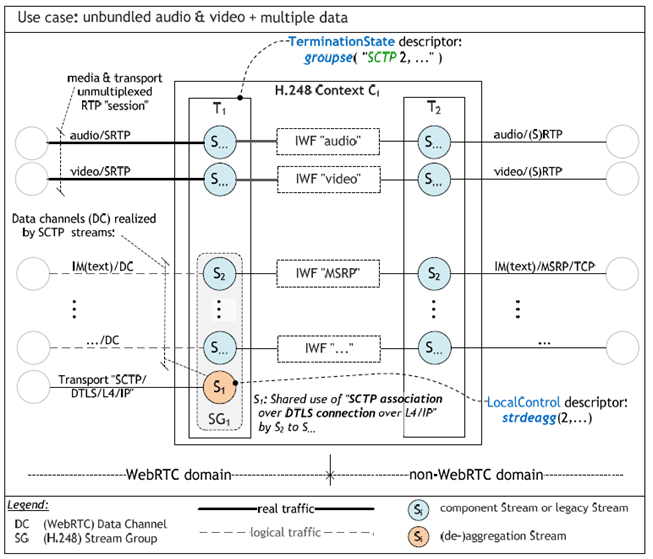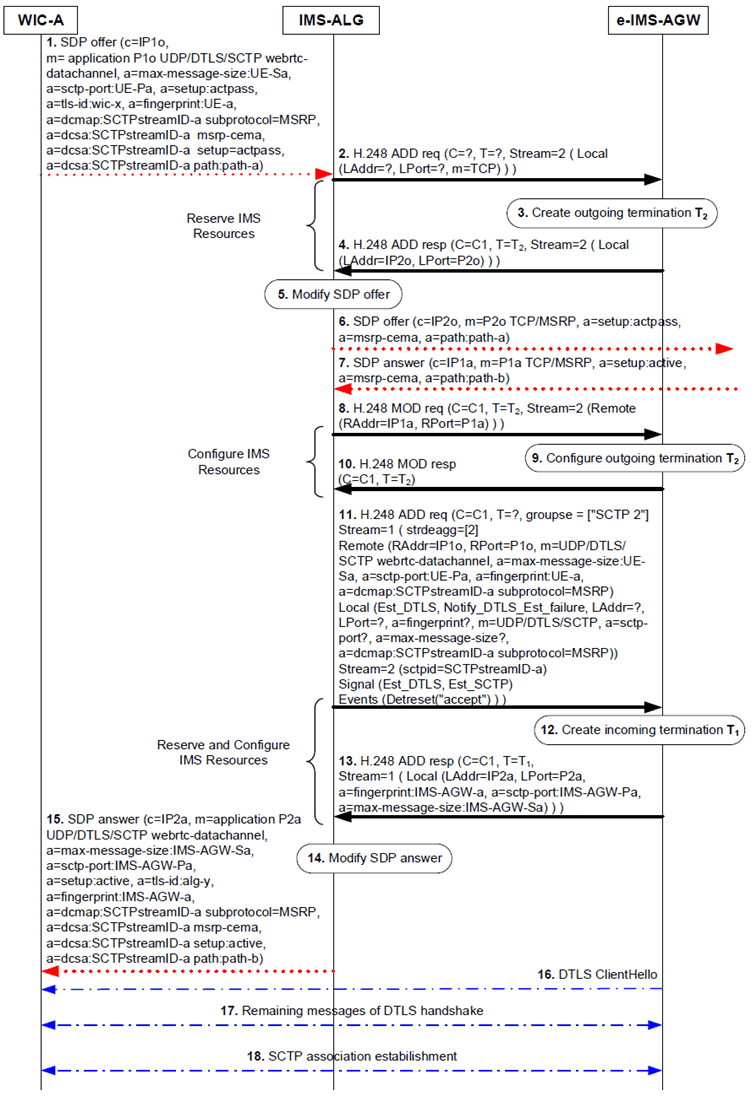Content for TS 23.334 Word version: 17.2.0
1…
4…
5…
5.11…
5.12…
5.14…
5.18…
5.19…
5.20…
5.21…
6…
6.1.6…
6.1.11…
6.2…
6.2.10…
6.2.10.3.1.2
6.2.10.3.2
6.2.10.4…
6.2.10.4.3…
6.2.10.5
6.2.10.6…
6.2.10A…
6.2.13…
6.2.14…
6.2.14.3
6.2.14.4…
6.2.15…
6.2.17…
6.2.17.3…
6.2.17.5…
6.2.18…
6.2.20
6.2.21…
6.2.22…
6.2.22.3…
6.2.22.3.2
6.2.23
6.2.24
6.2.25
7
8…
8.3
8.4
8.5…
8.23…
6.2.10.6 End-to-access-edge security for WebRTC data channels using SCTP-over-DTLS transport
6.2.10.6.1 General
6.2.10.6.2 Call flow for data channel establishment from WIC towards IMS access network and MSRP session establishment
...
...
6.2.10.6 End-to-access-edge security for WebRTC data channels using SCTP-over-DTLS transport |R13| p. 119
6.2.10.6.1 General p. 119
The requirements on eP-CSCF (IMS-ALG) and eIMS-AGW for the procedures to establish WebRTC data channels are specified in clause 5.20.2.
The following clauses describe extensions to the Iq signalling procedures and their interactions with SIP signalling in the control plane and with user plane procedures if the e2ae security for the WebRTC data channels using "SCTP over DTLS" is supported by the eP-CSCF (IMS-ALG) and the eIMS-AGW.
All message sequence charts in this clause are examples. The example high-level H.248 context model is defined in Figure 6.2.1.1 and further detailed below.
6.2.10.6.2 Call flow for data channel establishment from WIC towards IMS access network and MSRP session establishment p. 119
Support of multiple WebRTC data channels per WebRTC calls implies support of so called H.248 stream grouping. Figure 6.2.10.6.2.1 shows an example H.248 Context model for a WebRTC call with unbundled audio and video, and with multiple data components.

Figure 6.2.10.6.2.1: eIMS-AGW - H.248 Context model for WebRTC gateway inclusive H.248 Stream Group for WebRTC data components
(⇒ copy of original 3GPP image)
(⇒ copy of original 3GPP image)
The example flow in this clause focuses on the WebRTC data channel part only. Thus, only H.248 Streams S1 (for deaggregation of multiple data channels) and S2 (for MSRP traffic) are indicated subsequently.
Figure 6.2.10.6.2.2 shows the message sequence chart example for the WIC originated procedure to establish a WebRTC MSRP data channel using SCTP-over-DTLS transport.

Figure 6.2.10.6.2.2: WIC originated procedure for WebRTC data channel establishment and MSRP stream establishment
(⇒ copy of original 3GPP image)
(⇒ copy of original 3GPP image)
The IMS UE A embedded WIC-A performs an IMS originating session set-up according to TS 23.228 with modifications for support of WebRTC service control.
The procedure in the above Figure for requesting an MSRP profiled WebRTC data channel is described step-by-step with an emphasis on the additional aspects for eP-CSCF (IMS-ALG) and eIMS-AGW with regards to the creation of an H.248 Context for interworking MSRP-over-DC to MSRP-over-TCP:
Step 1.
IMS UE-A (WIC-A) sends an SDP offer for an MSRP WebRTC data channel. A new "SCTP association over DTLS association" is requested.
Step 2. - 4.
The eP-CSCF (IMS-ALG) uses the "Reserve AGW Connection Point" procedure to request a termination and H.248 Stream '2' for "MSRP-over-TCP" media towards the core network.
Step 5.
The eP CSCF (IMS ALG) modifies the SDP offer to offers TCP transport for MSRP, and to requests the remote peer to select the TCP setup direction.
Step 6.
The eP CSCF (IMS ALG) forwards the SDP offer.
Step 7. - 10.
The configuration of core network side H.248 Stream endpoint S2/T2 is completed based on the received SDP answer (7).
Step 11.
The eP-CSCF (IMS-ALG) uses the "Reserve and Configure AGW Connection Point" procedure to request a termination inclusive an H.248 Stream Group for WebRTC DC traffic. The eP-CSCF (IMS-ALG) uses an H.248 Context model with H.248 Stream grouping as required for WebRTC DC support. The Stream Group (SG) configurations according to Figure 6.2.10.6.2.1 is applied: The eP-CSCF (IMS-ALG) decides to assign H.248 StreamID value '1' to the H.248 deaggregation stream and to use H.248 StreamID value '2' for the WebRTC data channel. The following aspects should be emphasized:
Step 12./13.
-
H.248 deaggregation stream (S1):
- covers the protocol stack segment "SCTP Association over DTLS connection over L4/IP";
- the 'UDP' is indicated as L4 protocol;
- the SDP information related to the underlying ICE procedures is omitted in the abstracted ADD.req command;
- the deaggregation stream embedded SDP covers the attributes for configuration of the SCTP Association;
-
H.248 component stream (S2):
- covers the upper protocol levels of the logical DC and the IP application layer (here 'MSRP');
-
DTLS session/DTLS association establishment:
- an outgoing establishment procedure is enabled ("which will be executed by the eIMS-AGW after successful L4 connectivity");
-
SCTP association establishment:
- both, an incoming and outgoing establishment procedure is enabled ("in order to emulate "SCTP simultaneous open" behaviour");
- the eIMS-AGW would start to send an SCTP INIT chunk as soon as the DTLS connection is "data transfer ready" (see step 16);
-
Preparation of DC release already in DC establishment phase:
- Background: DC release is based on SCTP Association level SCTP Stream reset procedures. Incoming reset requests could be either autonomously handled by the eIMS-AGW or explicitly controlled by the eP-CSCF (IMS-ALG).
- The activation of a notification mechanism is required in any case (indicating the autonomous behaviour by the default value 'accept' of the correspondent event parameter).
The eIMS-AGW confirms the successful creation and configuration of the requested H.248 Stream Group for WebRTC DC traffic.
Step 14./15.
The eP-CSCF (IMS-ALG) then sends the updated SDP answer to the IMS UE-A embedded WIC-A.